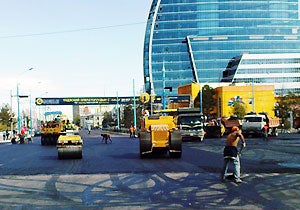 |
Financed by the mining boom, government spending on new infrastructure in Mongolia has increased 35-fold in the past 10 years. But you would not know this from driving the pot holed streets of Ulaanbaatar or inhaling the smog filled air of the city, particularly in the ger areas.
A new World Bank report I co-authored examines why this increased spending is not resulting in equivalent benefits for the citizens of Mongolia in terms of better roads, efficient and clean heating, and improved water and sanitation services.
The reasons are that much of this spending has been misdirected to low priority areas and activities, and has been wasted due to poor project planning and implementation. Correcting these weaknesses is urgently required to ensure that the government's ambitious spending plans — from the rapidly increasing budget and from new international borrowing, like the recent $1.5 billion Chinggis sovereign bond — result in good quality infrastructure.
Ulaanbaatar accounts for over 40 percent of Mongolia’s population and a bulk of its economic activity. Considerable economic research tells us that with proper infrastructure and favorable regulations, cities can be engines of economic growth, fostering innovation and raising living standards for the entire country. The citizens of Mongolia know this and that’s why they have been migrating to Ulaanbaatar in search of better paying jobs – the city’s population has increased by 60 percent over the past decade.
Yet Ulaanbaatar has been relatively neglected in government infrastructure spending. On average, it received less than 20 percent of the national roads budget over the past 5 years, and was similarly under-prioritized in expenditures on heating. Moreover, future government plans continue to neglect Ulaanbaatar; over the next four years the government plans to spend almost twice as much on rural roads as on Ulaanbaatar’s roads even though rural roads will not have anywhere near the traffic volumes needed to generate positive economic returns.
Spending can only result in good roads, schools, and hospitals if these are regularly and adequately maintained. Yet maintenance has been grossly neglected with the result that new infrastructure quickly deteriorates and then requires costly reconstruction. The government only spends a fifth of what is needed on routine road maintenance; it is therefore no surprise that 60 percent of the national road network is in poor condition requiring reconstruction. The ratio of maintenance spending to spending on new investments has been steadily declining over the past three years, pointing to more problems in the future.
Making sure that spending results in a good road or power plant being built also requires proper planning and sound construction. An infrastructure project needs a realistic cost estimate; the contract to the company to build the project needs to be given in a transparent and competitive manner; the contractor has to be properly supervised to ensure it does its work properly; and the construction company has to have the necessary skills and resources to do the job.
Right now none of these key links in the chain from spending to a good new road or other infrastructure is working satisfactorily. Cost estimates are unrealistically low; there is significant political interference in the award of contracts; construction companies cut corners during implementation compromising on quality, often in cahoots with the supervision engineers; and the whole system does not encourage the growth of the construction sector, which is currently greatly lacking in skilled engineers and workers.
So what needs to be done?
- Spending plans need to be tempered with the reality of the capacity to spend well, both the government’s capacity as well as the construction sector’s capacity. This is currently not the case, which then risks a lot of wastage.
- The spending has to be much more focused on Ulaanbaatar and on infrastructure maintenance to yield maximum economic returns. This can be easily achieved if there is the political will — for example, in the roads sector only a modest reallocation of 20 percent from new construction to maintenance last year would greatly improve the state of the national road network.
- The government needs to invest in its capacity to prepare and implement projects well. This will require having more staff in the ministries and local governments who can do the necessary technical analysis. It also requires taking the time and spending the necessary money for proper economic feasibilities of projects.
- There needs to be much more focus on independent project supervision, including providing opportunities for citizens to monitor projects. Without this emphasis on transparency and monitoring, the risks of corruption and wastage will remain because the rapid growth in spending provides ample opportunities for illicit enrichment.
- Mongolia needs to consider inviting foreign workers and companies who can make up for the shortage of skilled workers. Through specific partnerships, the government can ensure that those companies pass on their expertise and help improve the capacity of both the government and the construction sector.
Do you know of examples in other countries where spending in infrastructure has been improved? Would they apply to Mongolia? Share with us.


Join the Conversation